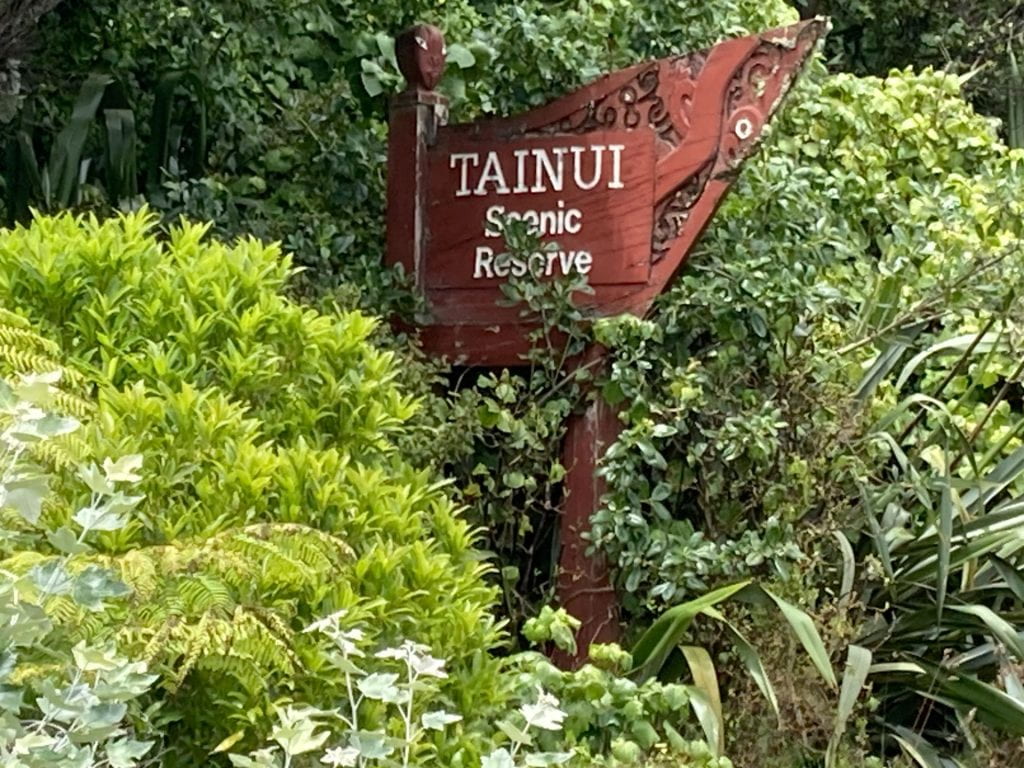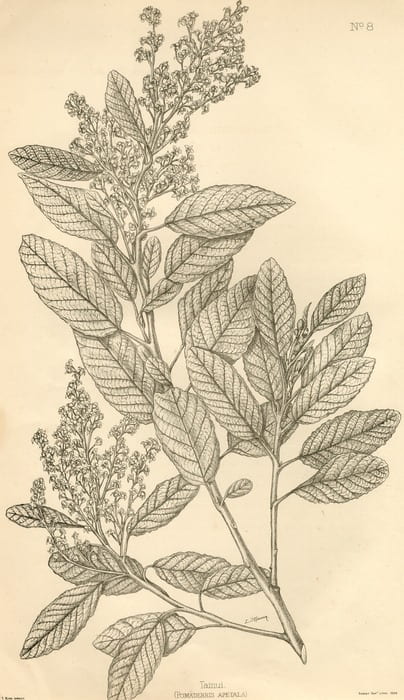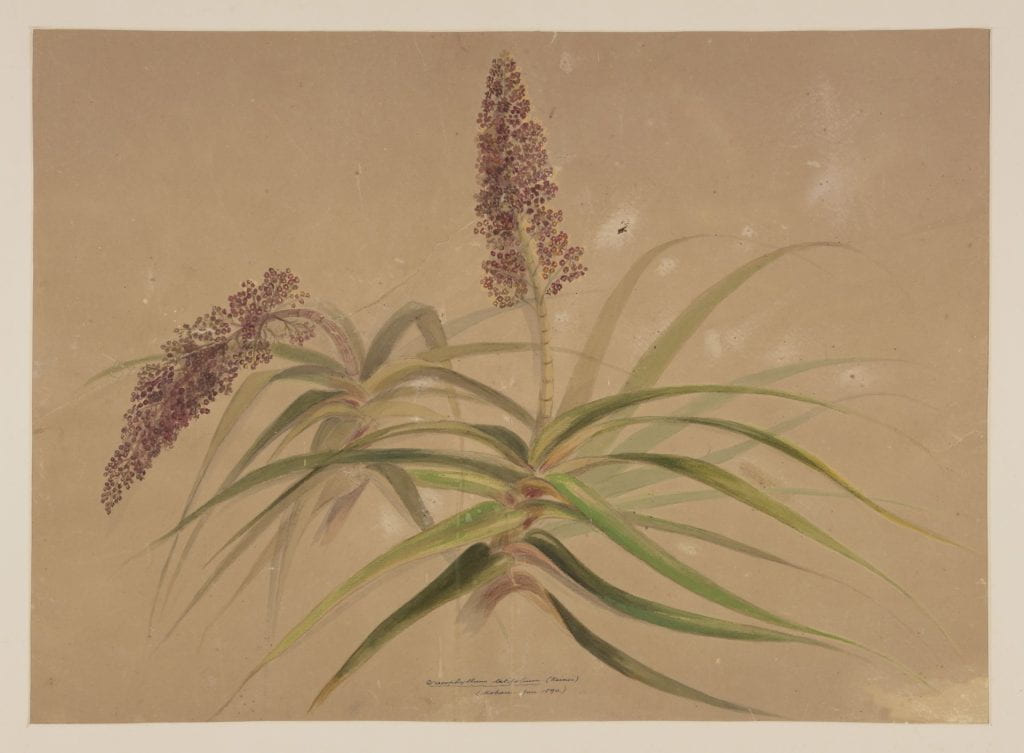By Michele Leggott, with research support from Catherine Field-Dodgson
I wasn’t dreaming. There really is a sign on the road north of Mokau and it says ‘Tainui Trees.’ We back up the car and Mark crosses the road where the sign is pointing. There he finds a signboard for Tainui Scenic Reserve, topped by a carving in the shape of a canoe prow. The adjacent driveway leads to a gate on which there is a private property notice. There is no obvious access to the reserve. We take a photo of the signboard and keep going north, not much closer to seeing the famous trees to be found in only two or three locations on this coast.

On an earlier trip we looked for the tainui trees between Mohakatino and Mokau, where local iwi showed government surveyor James Hector a grove covering nearly an acre. That was in 1878 and the grove was on land leased at the time to settler Joshua Jones. Hector passed on his findings in a paper for the New Zealand Institute the following year:
Art. LXIV.—Notice of a new Species of Pomaderris (P. tainui.) By. Dr. Hector. [Read before the Wellington Philosophical Society, 11th January, 1879.]
The tree which I have to introduce to the Society was discovered during my recent visit to the Mokau district… It is a very local plant, being confined to about an acre of ground on a spur of the low sandy hills that extend along the coast, between the Mokau and the Mohakatina rivers. The peculiar habit of the tree first attracted my attention, having a resemblance to a clump of apple trees, so that at first glance I thought it to be an old orchard or cultivation. I afterwards was much interested in hearing from the natives that a peculiar tree was growing on the spot where their ancestors first camped when they abandoned the Tainui canoe, in which they came from Hawaiki, and that this tree had sprung from the rollers or skids and the green boughs that were brought as flooring to the great canoe. On my doubting this, they offered to take me to the place, and if I could not recognise the tree as being found elsewhere in New Zealand, they would consider it as proof that the tradition was correct. To my surprise they took me to the clump of trees I had previously observed, and as it is certainly quite distinct from any plant hitherto described from New Zealand, the tradition receives a certain amount of confirmation; and I need hardly point out that if it were true, and we could hereafter determine the original habitat of this tree, it might give us a clue to the whereabouts of the mythical Hawaiki, or the place whence the Maori originally migrated to New Zealand.
When Thomas Kirk was compiling his Forest Flora of New Zealand ten years later, Pomaderris Tainui got a plate to itself and a name change. Under the headings ‘Pomaderris apetala’ and ‘The Tainui,’ Kirk explained his doubts about the legendary origins: ‘As, however, the genus Pomaderris is absolutely restricted to Australia and New Zealand, the legend, like many others, appears to be without foundation.’ He went on to credit his own sources of information about the tree, both from Europeans living on the coast:
“I was informed by Sergeant Gilbert, of the Armed Constabulary, that it occurred by the sea in Kawhia Harbour, in the Auckland District; also that he had observed a solitary plant growing near the sea between Kawhia and Mokau. The first-named habitat was confirmed by Mr. Jones, a settler at the Mokau. It covers fully an acre of ground between the Mokau and Mohakatina Rivers, Taranaki. Under cultivation this species is of rapid growth when the conditions are favourable, attaining the height of 12ft. in four years ; after that its rate of growth is evidently slower. It is very common in some districts of Victoria, where it attains the same height as with us, and is known as “hazel.”

Kirk, ever conscientious, added a note to his entry on the tree:
Since the preceding was written Major Gudgeon has, at my request, kindly forwarded recent specimens of the plant to the officer in command of the Armed Constabulary station at Kawhia, and instructed him to ascertain if the plant still exists in that locality. He reports that he can find no trace of it, although on showing the specimens to the chiefs Hone te One and Te Huki, and other old Natives, they recognised it as a plant which formerly grew between the present township and the mouth of the river, but was killed by goats, which were very numerous many years ago. They stated that it was termed “whariki” or “tainui,” and that it grew from the “whariki” which was thrown out of the great canoe when it landed there. They state that the “Tainui” landed at Kawhia (not near the Mokau, as stated by the Natives living on that river), and point to two rough stones standing in a patch of manuka about a mile from the township, going towards the mouth of the river, which, according to their statement, mark the length of the canoe on the spot where it was hauled up and left to decay.”
When Emily Harris painted two flowering plants from Mokau in January 1890, she was staying in New Plymouth with her sister Mary Weyergang. Mary was an enthusiastic gardener and plant collector, and her house on Devon St East had a well stocked flower garden and a small fernery. The sisters often went ferning together when Emily was in Taranaki. Emily’s large watercolour of the red neinei Dracophyllum latifolium is inscribed ‘Mokau – Jan. 1890’ and was much admired in exhibitions in Nelson and Wellington later that year. Reviewers also admired a painting of the tainui tree from Mokau, citing the legend as it appears in Hector’s account rather than Kirk’s. The painting itself has disappeared but it and the red neinei are likely to have been made from fresh cuttings brought to Emily in New Plymouth by someone living or visiting Mokau, 80 km away by sea on the North Taranaki coast.

The source of the plants is probably Joshua Jones or his wife Mary, perhaps via Mary Weyergang and her horticultural connections. Jones brought his farm produce to New Plymouth by means of a small coastal cutter, making regular runs between the Mokau rivermouth and Port Taranaki. In 1890 road access between Mokau and New Plymouth was still tenuous. Emily’s diary tells us her January was packed with exhibition preparations and a trip to the lower slopes of Taranaki Maunga. There was no time to make a trip up the coast, even to see the famous trees in flower. She painted the tainui again in 1906 in one of the large flower studies commissioned for the New Zealand International Exhibition in Christchurch. That painting, an oil, has also disappeared but its title indicates Emily’s continuing pleasure in the traditional knowledge associated with the tree.
Others were dismissive of the legend, sometimes offensively so. An article in the Manawatu Standard in 1911 is smug in its assertion of the superiority of European science. After describing Hector’s interaction with local informants the writer continues:
But unfortunately for the lover of romance there is a sequel to the tale. When the earthen pot of tradition, and the iron pot of science, go down stream together, it is. the former which is likely to be broken. Professor Kirk has shown that the plant is none other than the Australian Pomaderm Apetala. Moreover, the genus Pomaderris, so far as it is at present known, is peculiar to New Zealand and Australia, and does not occur in the South Seas. It is obvious, therefore, that the story has grown up to explain the tree, and that the presence of the plant in New Zealand is no proof of the truth of the legend.
Kawhia? Mokau? Mohakatino? All are Ngāti Maniapoto / Tainui rohe. The trees associated with the canoe still grow where they were seen by Pākehā eyes in 1878 and by Māori eyes long before that. A more thoughtful interpretation of plant and tradition occurs in a recent profile by Philip Smith on the O2 Landscapes website:
Despite its success in other areas, it is extremely important to maintain its survival in its true home, on the coastal fringe from Waikato to north Taranaki.
Meanwhile, in cultural terms, it has elevated status within Tainui tradition – as legend states that it was brought to New Zealand as canoe flooring/skids on the Tainui canoe. The veracity of this is highly doubtful, due to the fact that the genus Pomaderris is endemic to New Zealand and Australia. However, that does not decrease the cultural importance of the plant; as it may well have played a role as canoe skids along the western coastline, when early Maori arrived (and recognised its suitability to this purpose).

Grove of tainui trees. Photo by Philip Smith
Thomas Emmett of the Waikato Botanical Society led a weekend trip to the Mokau region in the summer of 2021. The party visited several sites, starting with Tainui Scenic Reserve:
On the Saturday, our first visit was to Tainui Scenic Reserve, home to the largest remnant population of Tainui (Pomaderris apetala subsp. maritma). Tainui is critically endangered in New Zealand but is secure in Australia growing in Victoria and Tasmania. Tainui Scenic Reserve is one of three remaining sites in NZ where Tainui still grows naturally, the other sites are the Mohokatino Swamp which we visited on the Sunday, the other is a small isolated patch on private land about 1 km down the road from Tainui S.R.
The reserve is a long, narrow strip that runs up to a large pa site at its eastern end and is broken into three blocks of original Tainui dominated forest, planted Tainui forest and remnant coastal forest (Myoporum laetum, Olearia albida and Vitex lucens) mixed with gorse (Ulex europaeus).
The Maniapoto Claims Settlement Act 2022 includes a section indicating a status change for the reserve:
87 Tainui property
(1) The reservation of the Tainui property (being Tainui Scenic Reserve) as a scenic reserve subject to the Reserves Act 1977 is revoked.
(2) The fee simple estate in the Tainui property vests in the trustees.
(3) The Tainui property is declared a reserve and classified as a scenic reserve for the purposes specified in section 19(1)(a) of the Reserves Act 1977.
(4) The reserve is named Tainui Scenic Reserve.
What next? According to a submission of June 2023, the Waitomo Regional Council (WRC) is trying to preserve the two known groves on the coast. And here among the acronyms is an explanation of the partly-obscured signboard we found by the side of the road just north of Mokau:
“The Tainui Scenic Reserve (SNA number R18001) is an extremely important site within the Waikato Region as it is one of only two protected sites with Tainui forest in the country… In addition, the site contains approximately 1 hectare of Tainui (Pomaderris apetala) – a nationally critical indigenous vegetation species. This species is known on only one other protected site, a short distance south of Tainui Reserve located at 0 State Highway 3 (centre coordinates: 1740973.49E 5716134.54N (NZTM projection).
… WRC submits that WDC and the landowners must consider reclassifying the Tainui Scenic Reserve and the SNA area located at 0 State Highway 3 (centre coordinates: 1740973.49E 5716134.54N (NZTM projection) to a ‘nature reserve’ (under section 20 of the Reserves Act 1977). This would reduce access to the site and ensure that the nationally significant, rare species on-site are protected, preserved and enhanced in perpetuity.”
Somewhere close to the Tainui Scenic Reserve signboard and on the hillside above the mouth of the Mohakatino River, the trees have put out their panicles of cream flowers again. Perhaps good fortune will bring to light one or more of Emily Harris’s lost paintings and we will see what she made of the tainui in its true home, on the coastal fringe from Waikato to North Taranaki.
Lovely! Here is more on the Tainui Trees… https://www.researchgate.net/publication/354587065_Negentropy_for_the_anthropocene_Stiegler_Maori_and_exosomatic_memory
Thanks for sharing that Ruth – a fascinating read. ^CFD